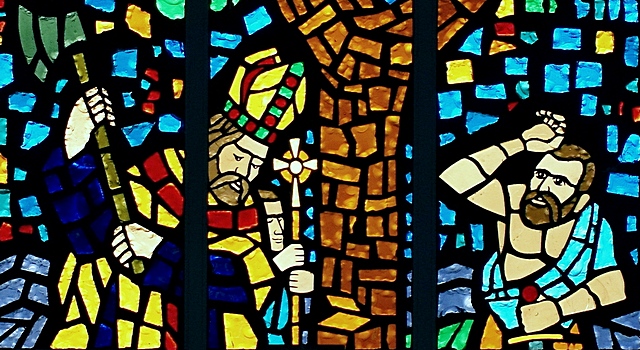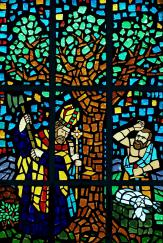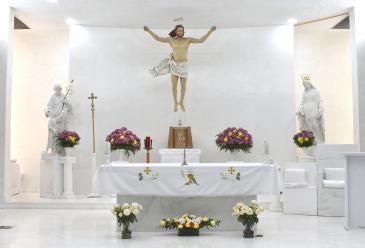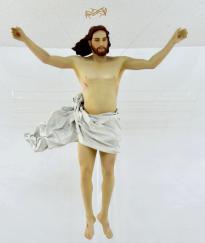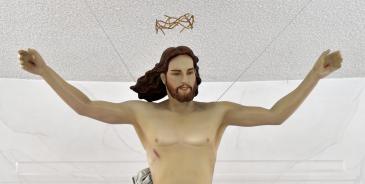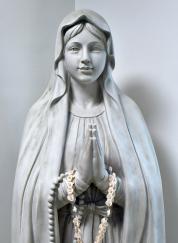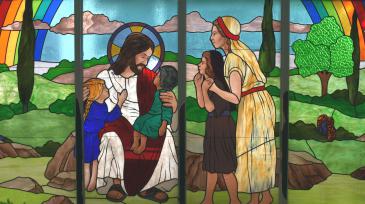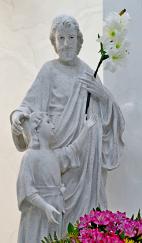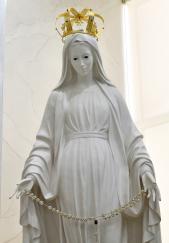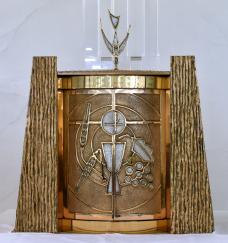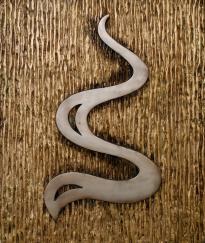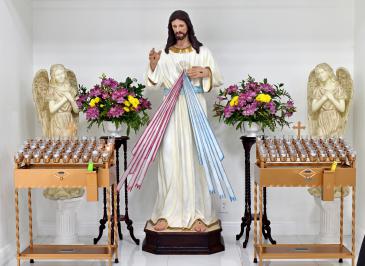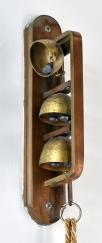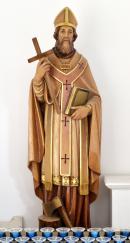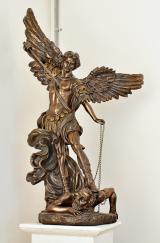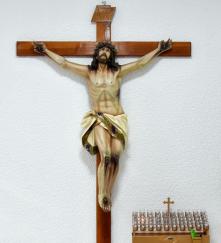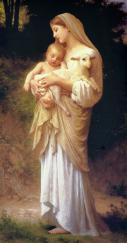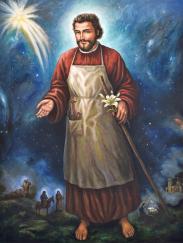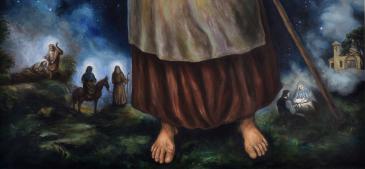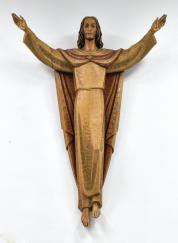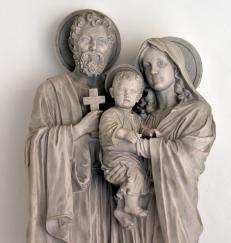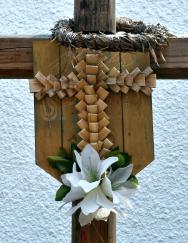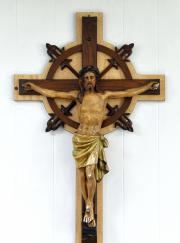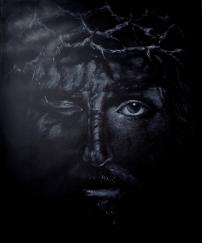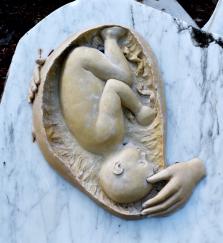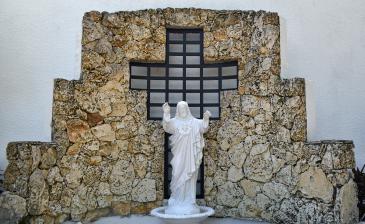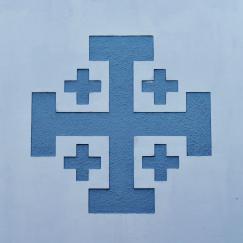By Jim Davis - Florida Catholic
Photography: JIM DAVIS | FC
PEMBROKE PINES | “Even now, the ax is laid at the root of the trees,” John the Baptist famously said. Boniface, this month’s saint, seemed to take that literally.
The eighth century bishop defied local culture by chopping down a tree dedicated to Thor. When that war god failed to strike him dead, pagans began converting to the God of the Bible.
Boniface’s talents, of course, went beyond wielding an ax. With a blend of scholarship, people skills, persuasiveness and church discipline, he is honored as the “Apostle to the Germans.”
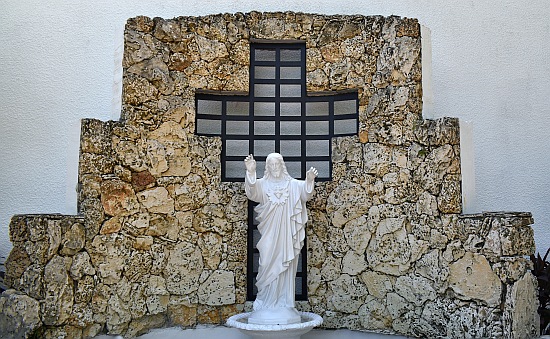
Photographer: Jim Davis | FC
Statue of Jesus' Sacred Heart, backed by a cross in a lattice frame, takes the center of this coral display at St. Boniface Church, Pembroke Pines.
Born Winfrid or Wynfrith in Wessex, England, he felt an early pull toward a religious vocation. He studied at Benedictine monasteries, gaining students’ respect for his teaching skills. He was ordained by the Benedictines around the age of 30.
Winfrid then followed other Anglo-Saxon missionaries to Frisia, in modern Holland – only to find the local ruler was warring against Christians and destroying churches and monasteries.
He went home after a few months, but returned to Europe to evangelize the Saxons. This time, he had the protection of the Frankish king Charles Martel, and Pope Gregory II had formally blessed his mission. The pope even renamed him Boniface, or “Doer of Good.”
Boniface got better results in Frisia, working alongside the veteran missionary Willibrord. After three years, Boniface went to Germany, where he heard of the Thunder Oak. The huge old tree, dedicated to Thor, was the focus of annual rituals.
He and his companions interrupted one of those rituals. After cutting down the tree – which, according to one story, fell into four pieces in the shape of a cross – he challenged the astonished crowd: “How stands your mighty god?”
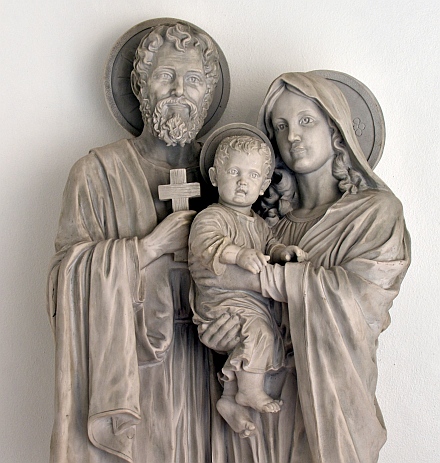
Photographer: Jim Davis | FC
Statue of the Holy Family takes a lush, Italian look in a chapel at St. Boniface Church, Pembroke Pines.
Boniface even gave the people another symbolic tree. Pointing to a small fir tree behind the downed oak, he said, “This little tree, a young child of the forest, shall be your holy tree tonight.”
Over the centuries, the tradition of using an evergreen tree for the birth of Jesus spread throughout Germany, then to America along with German immigrants. Some historians even say this was the birth of the Christmas tree.
Boniface adapted local customs to the faith as well. One was kegels, a game of throwing sticks at smaller ones. The bishop said the smaller sticks stood for demons, and knocking them down showed a pure spirit.
In 732, Pope Gregory III appointed him archbishop of eastern Germany. Boniface then began reforms among German churchmen who had become lax in morality and church practice. He appointed bishops and called synods and councils, and his standards revitalized the Church in the region.
Boniface reached the height of his power in 747, when Pope Zachary made him archbishop of Mainz and primate of Germany. Yet he resigned as archbishop and launched another mission tour – at the age of 73 – after hearing that a part of Frisia had deserted Christianity.
He must have known what might happen, for he took a shroud with him. Sure enough, a pagan band attacked in 754 with spears and swords, killing Boniface and 52 fellow Christians.
His feast day is June 5, the day of his martyrdom. He is regarded as the patron saint of Germany, Prussia, brewers, and tailors. He's also the patron saint of World Youth Day, held every three years.
Boniface’s namesake parish in southeast Florida was one of five established in 1971 by Archbishop Coleman Carroll. Created in Pembroke Pines, a city of 10,000 households, St. Boniface Church had its work cut out for it.
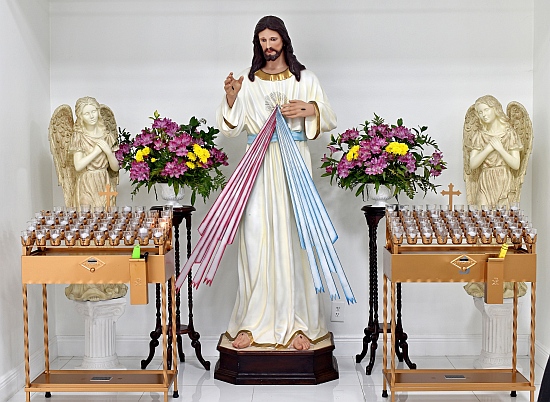
Photographer: Jim Davis | FC
Rays of blood and water flow from Jesus' heart in this statue at St. Boniface Church, Pembroke Pines. The statue is a rendering of a "Divine Mercy" vision in 1931 by Sister Faustina Kowalska, a Polish nun.
For the first two years, Masses were held at Boulevard Heights Elementary School and Pines Middle School. Two years later, the Diocesan Building Commission approved a plan for a parish center to seat 700. That multipurpose building was dedicated on Palm Sunday 1976.
Even then, the spiritual development of the church was evident. “I sense there is something special going on here,” Archbishop Carroll remarked in his dedication homily. “It is something called Christian community.”
Indeed, about 800 members underwent a conversion experience from 1975 to 1980 through baptism in the Holy Spirit. The parish then developed vigorous prayer life and several ministries.
Perpetual adoration of the Blessed Sacrament was introduced in 1982, with many families committing to an hour each week. A “Fisher Team” went door to door, inviting the lapsed and unchurched to return.
In 1999, the church recognized the congregation’s multicultural nature with Life in the Spirit seminars not only in English, but in Spanish and French.
Nowadays, church spirituality and service show in many ways. Members take part in Knights of Columbus, the Legion of Mary and the John XXIII Movement. Other activities include Cursillo and Emmaus retreats for men and women.
St. Boniface sponsors a prayer group, praise and worship services, and a Good Samaritan group to serve the needy in both the parish and neighborhood. The church also hosts meetings of Al-Anon.
